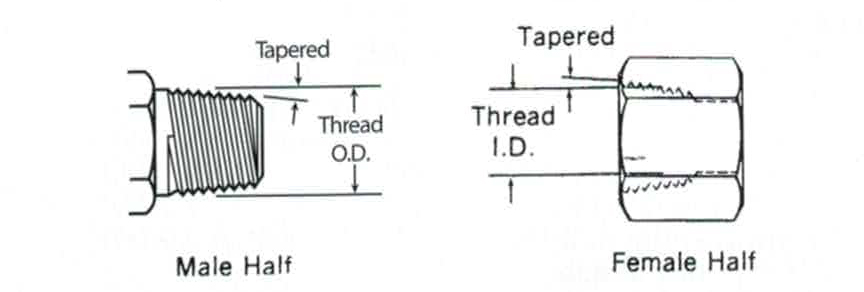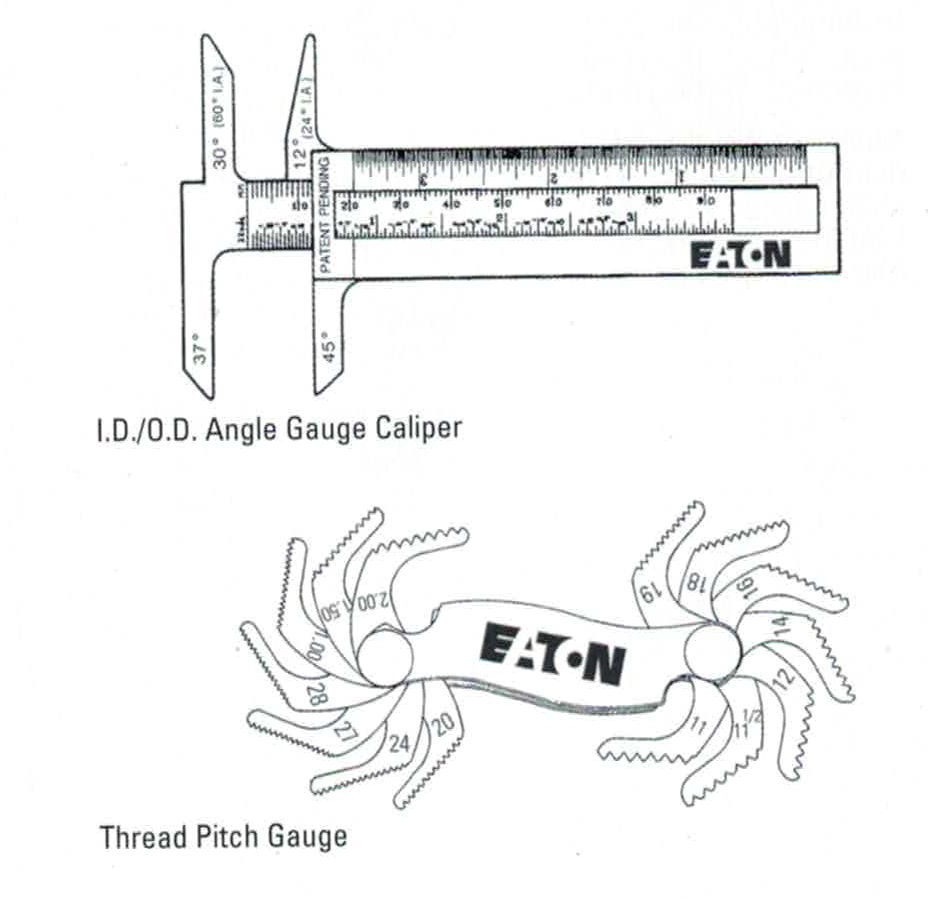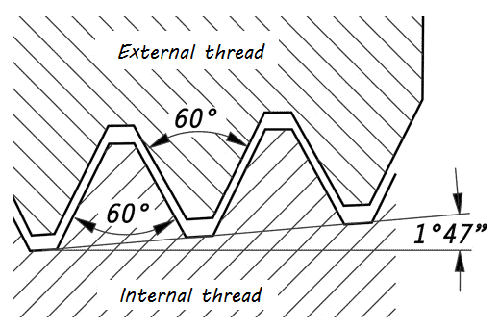NPT stands for National Pipe Tapered threads, also known as ANSI/ASME B1.20.1 pipe threads. It is a U.S. standard for measuring tapered threads on threaded pipes and fittings. Threaded pipes can give an effective seal for pipes using hydraulic fluids. Sometimes referred to as MPT (male pipe threads), NPT threads are not interchangeable with NPS (National Pipe Straight) threads. Unlike straight threads found on a bolt, a taper thread will pull tight, making a closer seal. A sealant compound or PTFE (Polytetrafluoroethylene) tape must be used to ensure a leak-free seal.
- angle between taper and center axis of pipe is 1° 47’ 24” (1.7800°)
- truncation of roots and crests are flat
- 60° thread angle
- pitch is measured in threads per inch (TPI)
Sizing
The NPT threads sizing chart includes data for external and internal pipe threads. The taper rate for all NPT threads is 1/16—3/4 in. per foot (62.5 mm per m)—which is measured by the change of diameter over distance. The outside diameter (OD) of a pipe or fitting must also be measured; both the TPI and OD are required for accurate identification of thread size because more than one size can have the same TPI.
Commonly used sizes include: 1/8, ¼, 3/8, ½, ¾, 1, 1 ¼, 1 ½, and 2 in. These can be found on pipes and fittings used by most U.S. suppliers. Sizes less than 1/8 in. are sometimes used for compressed air, while sizes more than 2 in. are less common, mainly because other joining methods are more often employed with these larger sizes.

Leakage issues associated with NPT
NPT threads were initially designed for water pipe plumbing (60 psi), not for hydraulic systems. However, they have been used in hydraulic systems for many years. Pipe threads in general are not recommended for high-pressure applications as they tend to leak more than any other style of connection. As previously mentioned, NPT requires some kind of sealant placed on the threads before assembly.
NPT threads are more likely to leak than their Dryseal counterparts; however, either thread type will leak if undertightened. A general tightening standard has yet to be established, but keep in mind that tightening requirements change with each re-use and/or type of sealant used. Also note that overtightening can crack the female port.

Measuring for a leak-free seal
In the imperial system, TPI is measured by how many crests (threads) there are per inch; the metric system measures the distance between two crests.
Using the trial-by-error method, try different thread gauges until you determine the tightest fit; engage as many threads as possible—the more threads engaged, the more accurate the reading. Hold the fitting and thread gauge up to the light, looking for gaps between the gauge and thread. This is easier to see on a male connection than a female one.
Next, measure the thread diameter with an ID/OD caliper. Male thread diameter is measured on the OD; female thread diameter is measured on the ID. The Hose Safety Institute Handbook recommends holding the caliper at a slight angle for a more accurate male reading, and holding it perpendicular to the thread for a more accurate female reading.
If the pipe or fitting connection seals on a flared surface or inverted angle seat, determine that angle of seal with a seat angle gauge on the male connection. Place the gauge on the sealing surface; if the centerlines of connection and gauge are parallel, the correct angle has been determined. For a female connection, insert the gauge into the connection and place it on the sealing surface. As with the male connection, if the centerlines are parallel, the correct angle has been determined.
References
Eaton Hydraulics. “How to Identify and Cure Piping Leaks”
www.eaton.com/hydraulics
Eaton Hydraulics. “Industrial Hydraulics Manual”
www.eaton.com/hydraulics
NAHAD Hose Safety Institute Handbook for the Design and Specification of Safe Hose Assemblies
www.nahad.org


Could you please post direct links to the Eaton documents “How to Identify and Cure Piping Leaks”
and “Industrial Hydraulics Manual” ?
Links provided in the article are to the Eaton literature library with over 1700 documents.
Are the dimension lines properly placed for the Thread ID on the “female half” view? I don’t think so.
Yeah I don’t think so either. One thing no one seems to mention either is that there are hydraulic npt fittings with somewhat of an inverted flare incorporated into the end of the hose end which mates to a protruding nipple in the mating fitting. This makes a npt which seals better for hydraulics nut I can find no information on this standard. It’s hit or miss buying hoses and fittings which may or may not have these features incorporated into them. Very frustrating.
Is there NPT with cone flare seat and inverted flare seat?
Same thing with NPS; is there NPS with cone flare seat and inverted flare seat?
Thanks
for those needing a flare or conical seat fitting, see vendors such as Parker, Swagelok for their catalog of fitting. Also military specs have details of straight conical fittings.MS33549, for instance.
The straight threads either seal on the conical faces or with an o-ring at the base of the thread. No sealant is required for those fittings. Also, the thread series is either imperial (US standard fine threads) or Metric (fine thread series) and not tapered like pipe fittings. they work well up to ultra-high pressures to 20,000 psig, and hold both liquids and gases.